by Sneha Sharma | Jul 28, 2023 | Children's Literature
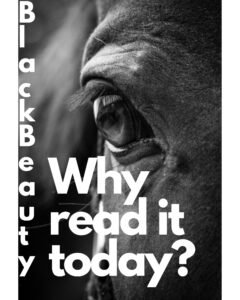
5 Timeless Lessons of Black Beauty: Why Everyone Should Read It Today
- The unfailing power of empathy
The story is grounded in the reality of our co-existence as living beings and is therefore universal in its applicability. It applies to animals, humans, and the rest of the living, breathing world around us. It is a poignant portrayal of the distressed condition of the poor cart riders who develop a certain callousness and lack of empathy towards their horses and passengers, that is forced upon them by poverty and work without break.
The cruppers (looped behind a horse’s tail), the breeches (passed behind a draft animal’s haunches), the halter, the iron shoes, the bridle with blinkers, the bit that goes into the animal’s mouth, the headstall (that has the bit and the bridle), the martingale and the girth – as if these accouterments weren’t enough for the horses, they were made to carry heavy loads and unkind passengers up and down the rocky hills.
- Co-existence is about friendship
The carefree colt standing under the apple tree in Birtwick with his friends, turning into a handsome well-bred horse, Black Beauty tells us this painful yet liberating story in first person. He changes many masters during his brave and formidable journey, where the only joy he experiences comes through compassion from his masters who befriend him and through his dear friend Ginger. Despite her distinct personality, Black Beauty accepts Ginger and she opens up to him, sharing the thick and thin of her journey until one day when they are separated. They do meet again on a high note when the story unfolds into showing us the depth of their unforgotten friendship. It is when Black Beauty observes his friend and is deeply saddened by seeing her condition. He prays with all his heart to liberate her from her mental and physical trauma
Black Beauty demonstrates incredible resilience and the ability to endure hardships. Despite facing challenges as a horse newly charged with carrying the passengers, men and women of displeasing nature, he still remains hopeful of finding a kind master and a place he can call his own and remains open to friendship, the way he experienced it in his initial training at Birtwick through his master and his mother who teaches him, how important it is to serve and treat the masters well.
- Experiencing intense emotions
Through Beauty’s life, the story pulls the reader into its emotional highs and lows, experiencing intense emotions and emerging victorious and hopeful. It teaches the children that life will have creases; situations beyond our control, and while the physical pain might take its own sweet time to heal, the mental state of positivity is the ultimate bridge to cross the river. It was fascinating to see Black Beauty go through the turmoil and still stay hopeful of finding a new life, especially towards the end when he is no younger and cannot be a fine runner as earlier, on account of his leg injury. He teaches the essential lesson of what happens when we experience pain on losing someone close, or when our body and mind are at odds with each other.
- Timeless power of living-breathing emotions.
The story belongs to a different era, culture, and geography than ours. It adds a perspective to our limited knowledge about the world and its intricacies beyond our reach, known only to those who breathe and experience it. From their survival, language, sartorial choices, architecture, flora, language and style of communication, the fauna, to the cuisine and the transport systems, the story set in lively historical backdrops, tells us everything in a natural and participative tone, where the reader and the storyteller blend in one equation, elope into the same background and disappear in the narrative.
The historical London we see through Beauty’s eyes is in contrast with the London we witness today with the touristy eye. The universal human emotions are not restricted by time or space or species and span through generations, connecting us with history in impossible and magical ways through timeless classics like these
by Sneha Sharma | Jun 2, 2023 | Children's Literature
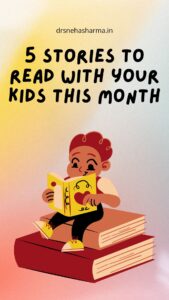
Ok. First things first. Let me tell you, the short list of books here is a choice based on my authentic review. I and my children have not only read these books but loved them throughout our reading journey. There are books we have read popular enough to recommend to you, but I am not willing to list them here just for the sake of it and simply because we didn’t enjoy them!
It would be advisable to ask children after every 10 pages of the book they are reading, if they are really enjoying it. Because the idea here is to motivate them to read more, not bombard them with stories they don’t enjoy.
So here’s my list of the month –
- Matilda – By Roald Dahl
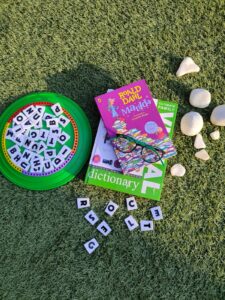
Enter the courageous world of this child prodigy with no less a thrill than one can expect from a Tom Sawyer story or Chronicles of Narnia. We might think the girl hero was lucky to have the ‘parfait’ brain of a genius, but her courage..her courage was a gift with no extraordinary tag..it was simply the one we all possess naturally!
And then you love the dialogues, especially Agatha Tunchbull’s. They probably come from Roald Dahl’s real-life school experiences with his harsh headmasters as he vividly narrates in his autobiography ‘Boy’!
A story worth reading twice, for the fun it promises and for its true-to-world characters!
Age Rating – 4-6 years.
- Gauri and the Talking Cow – Devdutt Pattanaik
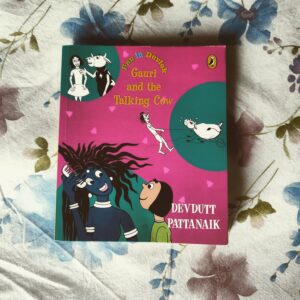
Here’s some Indian reading from our own mythologist Devdutt Pattanaik.
‘Kali’ – is for the wild, the scary forest-like..’Gauri’ – is for the garden, safe and domestic..they are the names of the same goddess in her different ‘avatars’..
As Sweety the talking cow narrates the story of Kali to Gauri, a girl who visits her village with her father, we know we are in for an amusing, informative and interesting tale.
My son and I loved the monochrome cartoon drawing assisting the text. The best part of the story was when Sweety narrates the tales of Raja Indradyumna and Raja Nruga both teaching two different aspects of good and bad conducts.
Couldn’t fathom why in Indradyumna’s story, Gods condition his stay in heaven on finding someone on earth who still remembers his good conduct. But as the author Devdutt Patnaik tells how stories, symbols and rituals construct the subjective truth (myths) of ancient and modern cultures around the world, in order to dive deep into it and abstract its true meaning, it’s advisable to explore the multiple layers of that truth. But at least stories like these trigger the essential curiosity in children that would turn their inclination towards the cultural myths and discover the real truth behind them.
Age Rating – 6-10 years
- Miss Rumphius’ by Barbara Cooney
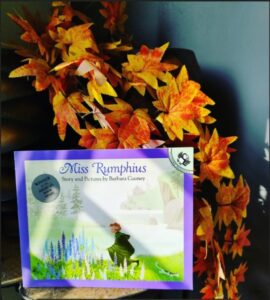
An article published in The Atlantic, titled ‘What Would Miss Rumphius Do’ in 2017, led me to buy this picturesque storybook for my children. ‘The Lupine Lady’ has become a household name since.
The beautifully painted characters and the lupines in different shades of blue and pink spread elegantly across the landscape pages of the book, sparkle like diamonds. The fact that it is a true story makes the protagonist even more lovable.
It concocts some unique takeaways for kids – we can all make the world beautiful in our own unique style and it starts with small consistent steps
And..
It’s important to take breaks and embrace boredom – as it was during one such phase when Ms. Rumphius carves out a way to fulfilling her grandfather’s wish, which was her dream too – ‘To make the world more beautiful than it already is.’
What does she do to make her dream true?
Find out in this beautiful story of ‘Miss Rumphius’ by Barbara Cooney
Age Rating – 6 – 10
Here are some helpful resources you can help your child with post reading the story.
https://www.prindleinstitute.org/books/miss-rumphius/
https://www.theatlantic.com/magazine/archive/2017/12/childrens-books-for-uncertain-times/544104/
- Timmy in Tangles by Shals Mahajan
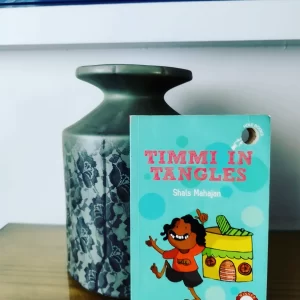
As a self-read, this handy 70-page book by Duckbill is the right fit for a light-hearted read during that extra time in the lunch-break or for quickly making those yawning fits disappear during class breaks.
I loved the illustrations by Shreya Sen, just the perfect support for the kids to enter into Timmy’s world.
Shals Mahajan takes children in the small but engaging world of Timmy, where she creates and befriends characters out of her own splendid imagination, who have been Indianized in a way it seems they actually reside somewhere in our surrounding. While to adults they might seem too strange and conceptually unidentifiable, surprisingly, they work too well with the kids. They quickly begin to see them with the eyes of Timmy!
My favourites – ‘Kichoo the cockroach’, playing a cameo but his dreaded long-‘mooch’-tickling is enough to compensate for the rest of his absence.
My 6-year-old, Anhad’s favourite character – ‘Idli Amma’ as she too loves Idlis like him and feeds on story food!
And how about ‘hanging’ a book by the bedside? I do that with the signature hole in the corner of these duckbill books!
Age rating – 5-9 years
- The Velveteen Rabbit by Margery Williams
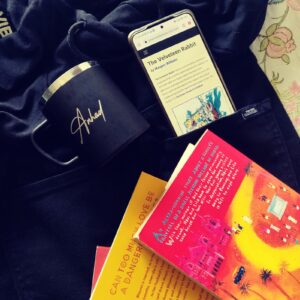
Excerpt from the story –
“What is REAL?” asked the Rabbit one day, when they were lying side by side near the nursery fender, before Nana came to tidy the room. “Does it mean having things that buzz inside you and a stick-out handle?”
“Real isn’t how you are made,” said the Skin Horse. “It’s a thing that happens to you. When a child loves you for a long, long time, not just to play with, but REALLY loves you, then you become Real.”
“Does it hurt?” asked the Rabbit.
“Sometimes,” said the Skin Horse, for he was always truthful. “When you are Real you don’t mind being hurt.”
“Does it happen all at once, like being wound up,” he asked, “or bit by bit?”
No.. It takes a long time. That’s why it doesn’t often happen to people who break easily, or have sharp edges, or who have to be carefully kept, answered the skin horse.
******
Can the concept of love be more beautifully interposed with children than this? This story of love spoken from the perspective of a toy velvet rabbit blurs out the world outside and spotlights the two characters of the rabbit being loved so whole-heartedly in the most passionate, purest form of love that it comes to life – from the toy world to human, and the distant but familiar character of the young boy who loves his toy rabbit unconditionally!
The rabbit waits for the day when the boy chooses him as his playmate and wants to be a REAL rabbit to be able to LIVE with the boy he loves forever.
It intrigues children to think philosophically about what is ‘real’ – a physical form, being loved enough that makes us real, or being present in flesh and blood.
And then it answers very subtly – that a physical form is not being real, being in flesh and blood isn’t reality alone but being LOVED ENOUGH is!
What makes you real?
The capacity to love and be loved enough!
*****
While this is a personal round-up of books to read with your child this June, there are lots to explore from the Indian English and Hindi books as well.
by Sneha Sharma | May 7, 2022 | Creative Writing Tips
Voice in writing
Having a clearly defined literary voice can have a timeless appeal. In a piece of fiction, voice can mean –
- Author’s voice,
- Character’s voice and
- Narrator’s voice.
The Narrator’s voice –
The narrator is the ‘all-seeing eye’ of a story. In a case where there can be no specific attribute or name given to the narrator (Hills like White Elephants by Earnest Hemmingway), it can still have that omniscient point-of-view or POV, which can access characters’ feelings and thoughts and knows where the story is taking the reader. The narrator’s voice is the voice of the character or personality narrating the story. This voice can be different from the author’s voice, unless the author is narrating the story herself, like in case of personal essays, where she would consciously try to reveal her style of writing to the reader and would like to adopt an honest, natural tone to stay as close to her own personality as possible. While doing this, she would also understand how this style of writing relates to her audience.
So, narrator’s voice is the voice of the person telling the story. Just like in a Radio drama, we are able to tell the character’s voice from the narrator’s voice, while reading fiction, we can discern the same. We can tell one voice from the other. The narrator will have his own set of diction, mood and style of telling the story and can take a particular POV (Point of View.), different from the Author’s.
Character’s voice –
A story can have multiple character voices. A character’s voice tells us about their personality, disposition (characteristic attitude) and background. In a story every character has their own way of expression. He may sound casual or cautious, terse or verbose, traits revealed by the way they use words and react in a dialogue or scene.
The precise elements that may be studied to understand a character’s voice are their –
- Tone
- Diction
- Dialect
- Level of introversion or extroversion
These elements may also reveal their age, nationality or life experiences.
For example, in E.B. White’s Charollete’s Web, Charollete, the female spider is like an old teacher with a caring and selfless demeanor when she speaks to Wilbur, the pig. She speaks with clarity and there’s an inspirational slant in her language.
“These autumn days will shorten and grow cold. The leaves will shake loose from the trees and fall. Christmas will come, then the snows of winter. You will live to enjoy the beauty of the frozen world, for you mean a great deal to Zuckerman and he will not harm you, ever. Winter will pass, the days will lengthen, the ice will melt in the pasture pond. The song sparrow will return and sing, the frogs will awake, the warm wind will blow again. All these sights and sounds and smells will be yours to enjoy, Wilbur — this lovely world, these precious days…”
- Charollete, from Charollete’s Web.
Wilbur, on the other hand is diffident and low in self-esteem.
“But Charlotte,” said Wilbur, “I’m not terrific.” – Wilbur (when Charollete decides to spin the word ‘Terrific’ through her web, for the him.)
Author’s Voice
The author’s voice is her personality coming through on the page. It includes everything from her tone (attitude towards a problem), her word choice or diction, punctuation and sentence structure. Her thoughts, part of her voice, are also conveyed through the voices of her characters and their background like age, nationality etc.
An example of voice could be the long, crafty sentences of Dickens or, cut to the chase sentences (without much use of adverbs) of Hemmingway.
An author’s voice is also determined by –
- Mood
- Or worldview
- Point of View
Voice of the following authors transcends their individual work –
- Earnest Hemmingway
- Toni Morrison
- James Joyce
- Joyce Oates
- Margret Atwood
- Nathaniel Hawthorne
Meaning of the worldview –
Every author has a picture they paint of the world. There’s a certain way they think about the world according to their own values, experiences and learnings. A worldview or perspective, is what an author thinks about worldly topics like – love, family, terrorism etc. and this can be narrated through the characters in fiction and through first or second person point of view in case of Non-fiction.
For example, if I am standing facing the façade of a large building and if I were to tell somebody how the building looks, I would give the description of the facade. It’s like seeing something from one angle and only talking about that angle in detail. Like talking from a young man’s perspective, the story might take us into different action-oriented scenes, making us feel that life is really adventurous, and from an old man’s perspective it might be more observational and analytical.
by Sneha Sharma | Dec 18, 2021 | Children's Literature
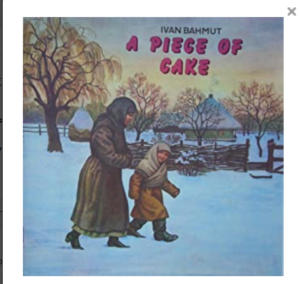
During Diwali vacations this winter, I found in my old library, the book I had so much cherished as a child. It was the story, my father read out to me when I would be tucked in bed or laze on the drawing room sofa, or simply when I demanded.
A Ukrainian folk tale, the book belongs to one of my brilliant memories of story listening experience from my parents, when I was a child and it is a treasure, I would forever behold.
The book ‘A Piece of Cake’ written by Ivan Bahmut, is a story (that runs in flashback), of a little boy named Mikolko, who is happy to be invited over for a dinner party at his Aunt’s. He’s happy also because he gets to wear his father’s shoes. His own, are torn. Mother instructs him to behave gentlemanly and not to gorge on the food Aunt Kalyan serves to him, as they are poor and might be made fun of by the arrogant Aunt; a point which the innocent Mikolko does not completely fathom.
Going by his mother’s instructions, when finally, the children are served dessert – a cake, Mikolko takes only a piece when insisted. When he tries to have a second helping, mother catches him in the act and so does his Aunt. To save his mother the embarrassment, he makes an excuse, that it was the cat he was feeding the cake to! When Aunty tries to humiliate him further by saying how could a cat eat a cake, her jovial son snatches the cake from Mikolko’s hand and feeds it to the cat, who relishes it like anything.
The Aunt stands sullen faced and openly shows disregard for Mikolko and his father, calling him a thief, while Mikolko’s mother cries tears of pride and love on the pleasurable discovery of his son’s mature understanding.
The description of mother’s fear of humiliation and being called out for her poverty, earlier in the story and during the dinner party are natural, real, touchy, naïve and painful.
The book although mentioned in the Goodreads, does not have much literature about either the story or the author. This is unfortunate, because the folklore shows us how children interpret the essential emotions and feelings, like embarrassment and pride, reflected through their parents’ non-verbal expressions, instead of directly experiencing them.
by Sneha Sharma | Oct 23, 2021 | Book Discussions
I read ‘The Cat Person’ posted on New Yorker sometime back and it’s a story you feel compelled to read in one go. I liked it because it was contemporary, realistic and feminist. In spite of its American setting/backdrop, it had a universal appeal. The theme was loud and clear – The power imbalance between older men and younger women dating each other.
It also highlights the concept of consensual sex – how there can still be elements of emotional molestation and superiority and subjugation, falling heavy on female assertiveness.
There were layers of following sub-themes too –
- Dynamics of coercion
- the highly manipulative and self-delusionary phase of early courtship,
Margot is scared of being judged by her boyfriend. She is aware of the storm that would follow if she breaks up with him on the grounds of bad sex. To her horror, the guy does not take the rejection on a casual note and abuses her verbally, pestering her, flooding her phone with mean messaging! No matter how much we advance in this constantly changing landscape of technology, space and astronomy, our fundamentals of a happy survival remain flawed, which starts with the relationship with the women around us.
A young woman in the age of her so-called independence, belonging to the era past feminism and modernism, still feels savaged and besotted by the technology and her relationship with a man.
Other facts about “Cat Person” by Kristen Roupenian –
Cat Person went on to get more than 4.5m hits and become the most-read piece of online fiction the New Yorker has published and has also been prosecuted as part of a ‘man-hating liberal agenda’ by many on social media.
Roupenian’s short story collection – ‘You know You Want this’ has won Roupenian a reported $1.2m advance and is being adapted into an HBO series. The stories work in the theme of – ‘the extent to which men rejected by women hate women, and women rejected by men hate themselves.’
Read the story here –
https://www.newyorker.com/magazine/2017/12/11/cat-person
Suggested Reading –
https://www.theguardian.com/books/2019/jan/26/cat-person-author-kristen-roupenian-dating-ego-power-control
https://www.washingtonpost.com/news/soloish/wp/2017/12/12/why-cat-person-a-new-yorker-short-story-is-essential-reading-for-this-metoo-moment/ –








